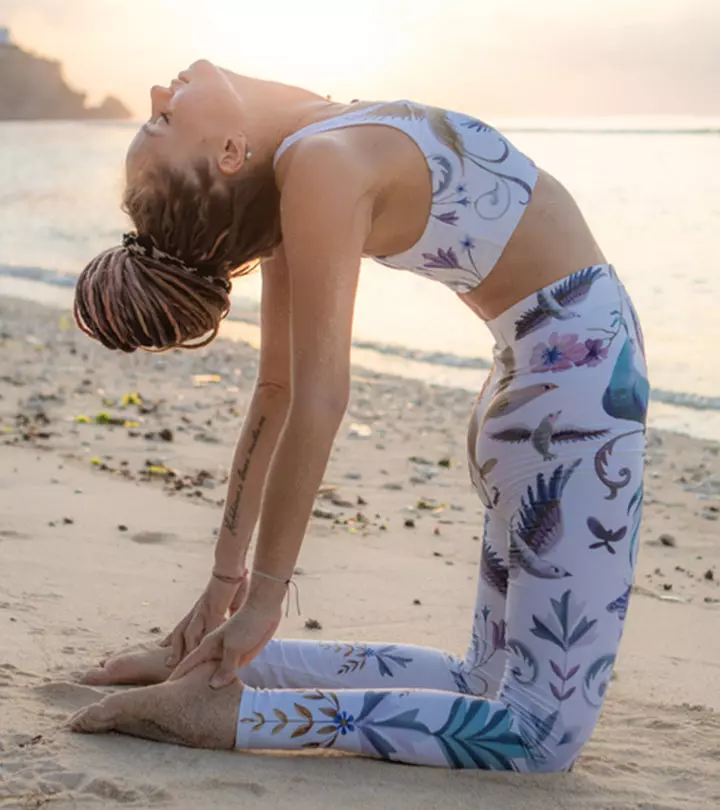Gout Diet To Reduce Uric Acid: Foods To Eat And Avoid
Learn which foods can help reduce uric acid in the body and facilitate recovery from the condition.

Image: ShutterStock
The use of a gout diet to reduce uric acid has been gaining popularity in recent times. Gout is painful, reduces the range of motion, and can make doing simple tasks tough. While medicines may give temporary relief, they are not a permanent solution. If you want a long-lasting solution to gout, you must eat well.
Gout is caused due to accumulation of uric acid. This is the reason diets with low amounts of uric acid are recommended. What you eat can make a big difference in managing gout. Following a good diet does not just help ease the pain; it can also help prevent future flare-ups by keeping uric acid levels in check. Continue reading to learn further about the gout diet and how it helps reduce uric acid. We also discuss what foods you need to include and what to avoid, and how you must follow the diet.
 At A Glance: Gout Diet
At A Glance: Gout Diet- Principle: A diet packed with low-purine foods and low on purine-rich foods.
- Purpose: To manage the symptoms of gout by reducing the levels of uric acid and inflammation in the body.
- Who It Is For: Individuals with gout
- Duration: Long-term
- Who Should Avoid: People taking warfarin and pregnant or breastfeeding individuals.
- Cons: May be challenging to follow in the long run due to low palatability.
In This Article
What Is Gout?
Gout is a painful inflammatory disorder of the joints triggered due to a metabolic disorder.
It is a complex but common type of arthritis.
It is caused due to overaccumulation of uric acid or uric acid monosodium urate (MSU) crystals in the synovial fluid (1). The synovial fluid is a fluid found in between all the joints that acts as a lubricant. Uric acid is the waste product of chemicals called purines. Overaccumulation of uric acid takes place when the kidneys fail to excrete this waste effectively.
Increased uric acid levels does not mean that you have developed gout. When serum uric acid reaches its threshold (above 9 ml/dL), MSU crystals are deposited in the joints (2).

In some cases, it also occurs when the body is unable to produce the enzymes involved in the metabolism of uric acid. Due to an increase in the levels of uric acid, the synovial fluid becomes less effective in lubricating the joints. This causes friction and leads to joint pain and inflammation, swelling, and unbearable pain. The joints become sensitive, red, and overheated (3) (4). It may also lead to kidney stones. (5)
Along the same lines, Sam Blum, a blogger shared his experience of dealing with extreme pain, stiffness, and soreness in his body due to gout. He recounted, “The rhythmic throbbing in my toe was too intense to sleep. Putting on a sock was suddenly an agonizing task. Walking to the bathroom was out of the question (i).” The blogger stated that though he was a healthy individual and indulged in athletics and martial arts, he felt that having gout wasn’t as uncommon as it might seem.
A study used data from 5,467 participants to determine the prevalence of gout in the U.S. population. According to it, the prevalence of the condition was observed to be 3.9% among U.S. adults. Out of these, 5.2% were men, and 2.7% were women. Additionally, they determined hyperuricemia (increased uric acid) prevalences, which were 20.2% and 20.0% in men and women respectively.
 Did You Know?
Did You Know?Key Takeaways
- Gout is a painful, inflammatory joint ailment brought on by a metabolic condition.
- It is recommended to eat foods low in purines or to avoid foods high in purines as much as possible.
- Foods such as spinach, strawberry, legumes, and nut should be consumed more.
- You can also consume Vitamin C supplements and grape seed extract may also help in treating gout.
- Gout-friendly workouts should be a part of your training routine.
How Does Low Uric Acid Diet Help Gout?

Uric acid is the waste product of purines that are found in many foods, such as seafood, poultry, meat, beer, etc. If your body is unable to process or eliminate uric acid, and that is causing painful inflammation in the joints, it is best to consume foods that are low in purines or limit the consumption of foods rich in purines. This will give your body enough time to eliminate uric acid from the system and lower the uric acid levels in the blood and synovial fluid. This, in turn, will cause less friction between the bones and alleviate the inflammation and swelling. A diet for managing gout is quite similar to an arthritis diet, which focuses on the consumption of foods with anti-inflammatory properties, but a diet list for gout also emphasizes eliminating foods that might increase uric acid levels in the body. Let’s find out what foods you should consume more, and foods you should completely avoid if you have gout.
Let’s find out what foods you should consume more, foods you should completely avoid, and foods you can have in limited quantities.
List Of Foods For Gout

Food To Eat More
- Vegetables – Spinach, asparagus, cauliflower, broccoli, carrot, beetroot, green peas, potato, and collard greens
- Fruits – Cherry, strawberry, blueberry, lemon, lime, grapefruit, oranges, pineapple, pear, and clementine
- Proteins – Proteins from all kind of vegetables like pinto beans and other legumes
- Carbs – Pasta, white flour, and bread
- Grains – Rice, couscous, and quinoa
- Beverages – Water, fresh lemon juice, fresh cherry juice, buttermilk, tea, and coffee
- Others – Nuts, parsley, flax seeds, and apple cider vinegar
Foods To Eat In Moderation
- Vegetables & Fruits – Tomato
- Animal Protein- Chicken and salmon
- Plant Protein – Legumes, beans, and pulses
- Grains – Oats
- Dairy – Low-fat milk, low-fat yogurt, and eggs
- Fats & Oils – Peanut butter and olive oil
Foods To Avoid

- Animal Proteins – Sardine, mackerel, anchovies, tuna, trout, herring, codfish, haddock, beef, bacon, pork, ham, veal, liver, scallops, duck, turkey, tofu, lobster, crab, squid, shellfish, oyster, and shrimps
- Carbs – Sweetbread, natural and artificial sugar
- Beverages – Alcohol and packaged fruit juices
- Fats & Oils – Animal fat, mayonnaise, and butter
- Others – High fructose corn syrup and chicken/fish/meat broth
How To Stay Properly Hydrated
Hydration is key when it comes to managing gout. Make sure you drink plenty of water throughout the day.
Ideally, you should aim for 8 to 10 glasses of water daily, but if you are active or it is particularly hot, you might need even more.
Proper hydration helps flush out uric acid from the blood, which is one of the main culprits behind gout. By staying on top of your water intake, you can reduce the chances of painful flare-ups and keep your gout under control.
Now that you have got an idea about the foods, it will be easier to follow a proper diet plan. The next section has a sample diet plan and you can use it as a template to design your own diet plan. Take a look.
Low Uric Acid Diet Plan
| Meals | What To Eat |
| Early Morning (7:00-7:30 am) | 1 cup water with 1 teaspoon apple cider vinegar + 3 soaked almonds |
| Breakfast (8:15- 8:45 pm) | Options:
|
| Mid-Morning Snack (10:30 – 11:00 am) | ½ cup cherries |
| Lunch (12:30 – 1:00 pm) | Options:
|
| Evening Snack (4:00 – 4:30 pm) | Options:
|
| Dinner (7.00-7:30 pm) | Options:
|
Why This Works
Apple cider vinegar, though not directly related to lowering symptoms of gout, can aid weight loss and increase metabolic rate, which is essential if you have gout
(6). Always be careful to take enough water along with it to maintain pH balance.
Always have a healthy well balanced breakfast before heading out. In this diet plan, low-uric acid breakfast options are listed. They are filling, nutritious, and keep your energy levels up. Since cherries are the go-to fruit for treating gout , have half a cup of cherries as a mid-morning snack. Keep your lunch light. Cherry juice benefits for gout as it may reduce inflammation (7).
Green tea is great for an evening snack as it helps to scavenge harmful oxygen radicals and reduces inflammation (8). If not green tea, a cup of fresh cherry juice or pineapple juice is great for reducing the inflammation. You may have chicken in moderate amounts for dinner. Potatoes are good for you, but make sure not to use full-fat cream to prepare the mashed potatoes. Both spinach and pasta are allowed foods, and the combo is a great option for dinner.
If you are a picky eater or allergic to any of the foods listed in the diet plan, here are the foods you can substitute them with.
Substitutes
- Apple cider vinegar – Lemon or lime juice
- Quinoa – 3 tablespoons of oats
- Coffee – Green tea
- White bread – Brown bread
- Peanut butter – Flax seed butter
- Blueberries – Strawberries
- Grapefruit juice – Orange juice
- Egg – 3 medium-sized button mushrooms, sliced and sauteed
- Orange juice – Pineapple juice or lemon juice
- Cherries – Blueberries or strawberries
- Salmon – 2 oz chicken
- Broccoli – Spinach
- Green leafy veggie salad – Vegetable clear soup
- Chickpea – 3 tablespoons yellow lentil soup
- Green tea – Coffee
- Cherry juice – Strawberry juice
- Pineapple juice – Orange juice
- Chicken – 2 oz duck or 3 oz salmon (without skin)
- Asparagus – Spinach
- Mashed potato – Mashed green peas and broccoli
- Pasta – Rice
So, you have a lot of options to choose from, which makes this diet plan is super easy to follow. However, there is one more factor that affects the severity of gout. And it is getting enough exercise or movement. Explained more in the next section.
Exercises To Treat Gout

Lack of exercise can worsen your gout. Hence, you should include gout-friendly exercises in your workout regimen. Make sure you consult your doctor before you start working out. Here is what you can do.
- Cycling
- Walking
- Swimming
- Stair climbing
- Dancing
- Stretching
- Strength training
- Yoga
Does The Gout Diet Work? What Eleana Kaidanian, RD, Says
Eleana Kaidanian
, RD, CDN, CPT-WFS, Says, “A personalized varied low-purine diet as advised by a registered dietitian is recommended to help manage gout symptoms. Choosing to reduce or limit consumption of high-purine foods and beverages can help prevent a gout flare. I recommend that in addition to following a low-purine diet for the management of gout, one should strive to achieve a healthier body weight through exercise incorporation and lifestyle modification as a means of further managing gout symptoms.”
She adds, “It is a fact that excess body weight, specifically adipose tissue, increases uric acid production in the body. Rather than follow a fad diet for weight loss, consult with a registered dietitian to provide you with an individualized, well-balanced plan that leads you to success.”
 Quick Tip
Quick TipSome people need an extra boost of nutrition apart from eating low-uric acid foods. For this reason, we recommend you take the support of supplements and other remedies to reduce the inflammation. Here is what you should do.
Supplement & Other Remedies To Treat Gout

You may take the following supplements or try other remedies.
- Vitamin C supplements (9)
- Quercetin and Folic acid supplements (10), (11)
- Ashwagandha (12)
- Castor oil (13)
- Pine bark extract (14)
- Grape seed extract (15)
- Celery seed extract (16)
- Colchicine medication (17)
- Allopurinol medication (18)
Consult your doctor before taking or using any of the above-mentioned supplements and remedies.
Infographic: Risk Factors Of Gout
Gout has been around for centuries and was known as the disease of the kings and the king of diseases. Though it is quite prevalent, following a few preventive measures can keep gout at bay. These measures usually include lifestyle changes and should be followed by people in the risk group. Check out the infographic below to understand who is at a higher risk of developing gout.
Some thing wrong with infographic shortcode. please verify shortcode syntaxThe risk of gout increases with the rising levels of uric acid in the blood. The best way to alleviate this painful joint condition is to decrease the intake of purine-rich foods, from which uric acid is released as a waste product. The uric acid diet, which comprises foods like spinach, cauliflower, broccoli, cherry, strawberry, grapefruit, and lemon juice, may help reduce inflammation and combat gout. This diet excludes alcohol (especially beer), packaged fruit juices, and animal protein (except chicken and salmon). A high-protein diet for gout is recommended for people as it can increase the production of uric acid. Also, avoiding or reducing alcohol intake is advisable. Do yoga and exercises like cycling, swimming, and stretching to strengthen your joints. Consult a doctor before going on a gout diet. You can consider the DASH diet for gout (19) and the Mediterranean diet for gout (20). A plant-based diet for gout is good if you are vegan (21) and a low-calorie diet for gout may not only help manage the symptoms but also help in overall weight management (22) to reduce the uric acid content in your body.
Frequently Asked Questions
Is banana good for uric acid?
High in vitamin C and low in purines, bananas make for a health fruit for gout.
Is honey good for gout?
Honey is a natural sweetener rich in fructose that can increase purine metabolism. It should therefore be avoided in a gout diet.
Does salt affect gout?
Yes, high intake of salt may help reduce uric acid levels (23).
Illustration: Gout Diet To Reduce Uric Acid: Foods To Eat And Avoid

Image: Stable Diffusion/StyleCraze Design Team
Having a hard time dealing with gout? Then check out this video that shows which foods to avoid and introduces the best diet tailored especially for people with gout.
Personal Experience: Source
StyleCraze's articles are interwoven with authentic personal narratives that provide depth and resonance to our content. Below are the sources of the personal accounts referenced in this article.
i. I’m Young and Healthy and Also Have Gouthttps://elemental.medium.com/im-young-and-healthy-and-also-have-gout-c4b48aae79e1
References
Articles on StyleCraze are backed by verified information from peer-reviewed and academic research papers, reputed organizations, research institutions, and medical associations to ensure accuracy and relevance. Read our editorial policy to learn more.
- What is Gout? Arthritis Foundation.
https://www.arthritis.org/diseases/gout - Gout: An old disease in new perspective – A review. Journal of Advanced Research, US National Library of Medicine, National Institutes of Health.
https://www.ncbi.nlm.nih.gov/pmc/articles/PMC5512152/ - Gout: Overview, US National Library of Medicine, National Institutes of Health.
https://www.ncbi.nlm.nih.gov/books/NBK284934/ - Uric Acid (Synovial Fluid). Health Encyclopedia, University of Rochester Medical Center.
https://www.urmc.rochester.edu/encyclopedia/content?contenttypeid=167&contentid=uric_acid_synovial_fluid - Uric Acid Nephrolithiasis
https://www.ncbi.nlm.nih.gov/books/NBK560726/ - Apple cider vinegar diet: Does it really work? Harvard Health Publishing Hardvard Medical School.
https://www.health.harvard.edu/blog/apple-cider-vinegar-diet-does-it-really-work-2018042513703 - Effect of tart cherry juice on risk of gout attacks: protocol for a randomised controlled trial
https://www.ncbi.nlm.nih.gov/pmc/articles/PMC7073821/#:~:text=In%20addition%20to%20lowering%20serum induced%20by%20monosodium%20urate%20crystals. - Evaluation of anti-inflammatory effects of green tea and black tea: A comparative in vitro study. Journal of Advanced Pharmaceutical Technology & Research US National Library of Medicine National Institutes of Health.
https://www.ncbi.nlm.nih.gov/pmc/articles/PMC3401676/ - Vitamin C Intake and the Risk of Gout in Men – A Prospective Study. Archives of Internal Medicine US National Library of Medicine National Institutes of Health.
https://www.ncbi.nlm.nih.gov/pmc/articles/PMC2767211/ - Quercetin lowers plasma uric acid in pre-hyperuricaemic males: a randomised double-blinded placebo-controlled cross-over trial. The British Journal of Nutrition US National Library of Medicine National Institutes of Health.
https://pubmed.ncbi.nlm.nih.gov/26785820/ - Folic acid reverses uric acid crystal-induced surface OAT1 internalization by inhibiting RhoA activity in uric acid nephropathy. Molecular Medicine Reports US National Library of Medicine National Institutes of Health.
https://www.ncbi.nlm.nih.gov/pmc/articles/PMC4768998/ - Suppressive effect of Withania somnifera root powder on experimental gouty arthritis: An in vivo and in vitro study. Chemico Biological Interaction US National Library of Medicine National Institutes of Health.
https://pubmed.ncbi.nlm.nih.gov/17084827/ - Effect of ricinoleic acid in acute and subchronic experimental models of inflammation. Mediators of Inflammation US National Library of Medicine National Institutes of Health.
https://www.ncbi.nlm.nih.gov/pmc/articles/PMC1781768/ - Effect of pine bark extract (Pycnogenol) on symptoms of knee osteoarthritis. Phytotherapy Research US National Library of Medicine National Institutes of Health.
https://pubmed.ncbi.nlm.nih.gov/18570266/ - Grape seed-derived procyanidins alleviate gout pain via NLRP3 inflammasome suppression. Journal of Neuroinflammation US National Library of Medicine National Institutes of Health.
https://pubmed.ncbi.nlm.nih.gov/28376889/ - Celery Seed and Related Extracts with Antiarthritic Antiulcer and Antimicrobial Activities. Progress in Drug Research US National Library of Medicine National Institutes of Health.
https://pubmed.ncbi.nlm.nih.gov/26462366/ - Colchicine
https://www.ncbi.nlm.nih.gov/books/NBK431102/ - Allopurinol
https://www.ncbi.nlm.nih.gov/books/NBK499942/ - The Dietary Approaches to Stop Hypertension (DASH) diet Western diet and risk of gout in men: prospective cohort study
https://www.ncbi.nlm.nih.gov/pmc/articles/PMC5423545/ - The role of the Mediterranean diet in hyperuricemia and gout
https://www.ncbi.nlm.nih.gov/pmc/articles/PMC7045958/ - Uric Acid and Plant-Based Nutrition
https://pubmed.ncbi.nlm.nih.gov/31357560/ - The Role of Diet in Hyperuricemia and Gout
https://www.ncbi.nlm.nih.gov/pmc/articles/PMC7886025/ - Opposing effects of sodium intake on uric acid and blood pressure and their causal implication
https://www.ncbi.nlm.nih.gov/pmc/articles/PMC5161245/
Read full bio of Madhu Sharma
Read full bio of Arshiya Syeda
Read full bio of Payal Karnik



























Community Experiences
Join the conversation and become a part of our empowering community! Share your stories, experiences, and insights to connect with other beauty, lifestyle, and health enthusiasts.